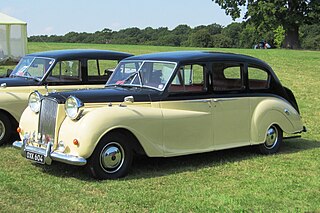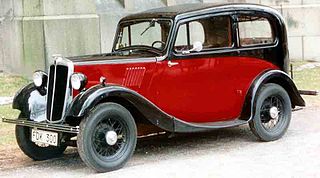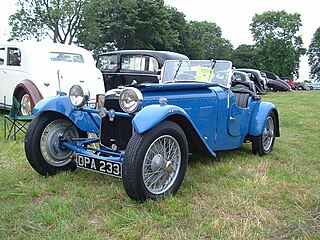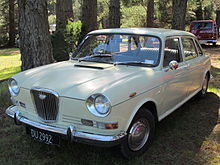
The Austin Princess is a series of large luxury cars that were made by Austin and its subsidiary Vanden Plas from 1947 to 1968. The cars were also marketed under the Princess and Vanden Plas marque names.

The Hillman Minx was a mid-sized family car that British car maker Hillman produced from 1931 to 1970. There were many versions of the Minx over that period, as well as badge-engineered variants sold by Humber, Singer, and Sunbeam.

BMC ADO17 is the model code used by the British Motor Corporation (BMC) for a range of cars in the European 'D' market-segment of larger family cars, manufactured from September 1964 to 1975. The car was initially sold under the Austin marque as the Austin 1800, then by Morris as the Morris 1800, and by Wolseley as the Wolseley 18/85. Later, with a 2.2 L engine, also as the Austin 2200, Morris 2200 and Wolseley Six. Informally, because of the car's exceptional width and overall appearance, these cars became widely known under the nickname "landcrab"

The Riley RM is a series of executive cars and compact executive cars that were made by Riley Motors from 1945 until 1955. They were the last models developed independently by Riley before its parent company, Nuffield, merged with Austin to form BMC. The RM series was produced in Coventry until 1949, when production moved to the MG works at Abingdon. Until 1952, models were marketed as the Riley 1½ Litre and the Riley 2½ Litre. the term RM has been used retrospectively to encompass models produced before 1952.

The Wolseley 4/50 and similar 6/80 were Wolseley Motors' first post-war automobiles. They were put into production in 1948 and were based on the Morris Oxford MO and the Morris Six MS respectively. The 4-cylinder 4/50 used a 1476 cc 50 hp version of the 6/80 engine, while the 6/80 used a 2215 cc 72 hp straight-6 single overhead cam.

The Wolseley 15/60 is an automobile which was produced from 1958 to 1961, and then, as the Wolseley 16/60, from 1961 to 1971. The 15/60 was the first of the mid-sized Pinin Farina-styled automobiles manufactured by the British Motor Corporation (BMC). Launched in December 1958 as part of BMC's Wolseley brand, the design would eventually be shared with seven other marques. All of the cars were updated in 1961 with a larger engine and new model designations. The Wolseley 16/60 was the last, in production until 24 April 1971.

The Morris Eight is a small family car produced by Morris Motors from 1935 to 1948. It was inspired by the sales popularity of the Ford Model Y, styling of which the Eight closely followed. The success of the car enabled Morris to regain its position as Britain's largest motor manufacturer.

The Morris Six Series MS is a six-cylinder midsize car from Morris Motors Limited which was produced from 1948 to 1953. Announced with Morris Motors' Minor, Oxford and Wolseley ranges on Tuesday 26 October 1948, it was Morris's first post-war six-cylinder car. All the new cars were of integral construction of chassis and body and rode on independent front suspension with torsion bars. At launch, the car was priced at £607 on the UK market, though the price rose to £671 on 1 March 1949.

The Standard Eight is a small car produced by the British Standard Motor Company from 1938 to 1959.

The Vauxhall Wyvern is a medium-sized family car introduced by Vauxhall in 1948 as a successor to the Vauxhall 12. The name comes from the mythical beast the wyvern, and may be due to a misidentification of the heraldic griffin on the Vauxhall badge.

The Vauxhall 10-4 is a British-built small family car produced by Vauxhall between 1937 and 1947. It was launched at the October 1937 London Motor Show and was the first British car to have a unitary construction body. The first car was delivered to a customer on 1 November 1937.

HRG Engineering Company also known as HRG, was a British car manufacturer based in Tolworth, Surrey. Founded in 1936 by Major Edward Halford, Guy Robins and Henry Ronald Godfrey, its name was created from the first letter of their surnames. Cars were produced under the HRG name from 1935 to 1956.

The Wolseley Ten is a light car which was produced by Wolseley Motors Limited in 1939 and from 1945 to 1948.

The Wolseley Eight is a four door, light saloon car which was produced by Wolseley Motors from 1946 until 1948. It was based on the Morris Eight Series E and also shared many body panels with the MG Y-type. At the time it was said to be Lord Nuffield's favourite car. The car was designed before World War II and was originally intended to have been launched in 1940. In line with the prevailing economic directives from the United Kingdom government, the majority of cars were exported.

The Daimler DB18 is an automobile produced by Daimler from 1939 until 1953. It is a 2½-litre version of the preceding 2.2-litre New Fifteen introduced in 1937. From 1949, the DB18 was revised to become the Daimler Consort.

The Vauxhall 14-6 is an automobile produced by Vauxhall in England from 1939 until 1948.

The Wolseley 14/60 is an automobile that was produced by Wolseley Motors in the United Kingdom between 1938 and 1948.

The Standard Fourteen is a British automobile produced by the Standard Motor Company from 1945 to 1948.
The Singer Ten name was used for several automobiles produced by Singer Motors between 1912 and 1949. The "Ten" in the name referred to the taxation horsepower rating in the United Kingdom.
The Singer Twelve name was used for several automobiles produced by Singer Motors. The "Twelve" in the name referred to the taxation horsepower rating in the United Kingdom.



















